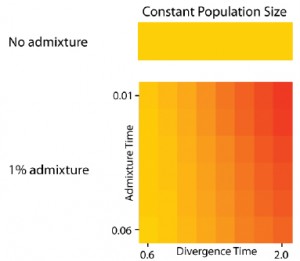Earlier this month, the Jaenike Lab published an article in Science on their striking discovery of adaptation via symbiosis in wild populations of the fruit fly Drosophila neotestacea. Using flies sampled from across North American over the past three decades, their work illustrates rapid and profoundly important spread of a bacterial symbiont that defends the flies against the sterilizing effects of a parasitic nematode. This work illustrates one of nature’s more unexpected strategies, and one that only became evident after decades of careful study in the field and laboratory. The Jaenike Lab’s work on adaptation via symbiosis has already been featured in outlets like Discover Magazine and the Guardian.
Category Archives: Research Updates
Geneva & Garrigan Report on Population Genomics of Secondary Contact
 A paper resulting from Anthony Geneva’s rotation in the Garrigan Lab just appeared in Genes. Using coalescent simulations, Geneva and Garrigan “describe the conditions for, and extent of, the introgression of genetic material into the genome of a colonizing population from an endemic population.” Their results show that our ability to diagnose reticulate evolution vary depending on a range of parameters, including population sizes, timing of secondary contact, and the duration of allopatry. One result they highlight is the finding that introgression is much more difficult to detect close to the time of a severe founder event than it is after the range of the colonizing species has had time to increase.
A paper resulting from Anthony Geneva’s rotation in the Garrigan Lab just appeared in Genes. Using coalescent simulations, Geneva and Garrigan “describe the conditions for, and extent of, the introgression of genetic material into the genome of a colonizing population from an endemic population.” Their results show that our ability to diagnose reticulate evolution vary depending on a range of parameters, including population sizes, timing of secondary contact, and the duration of allopatry. One result they highlight is the finding that introgression is much more difficult to detect close to the time of a severe founder event than it is after the range of the colonizing species has had time to increase.
Presgraves & Glor Dispatch on Island Speciation in Current Biology

The most recent issue of Current Biology includes a dispatch from Presgraves and Glor on island speciation. In this commentary, we discuss the implications of an impressive new study by Kisel and Barraclough in The American Naturalist on in situ speciation.
